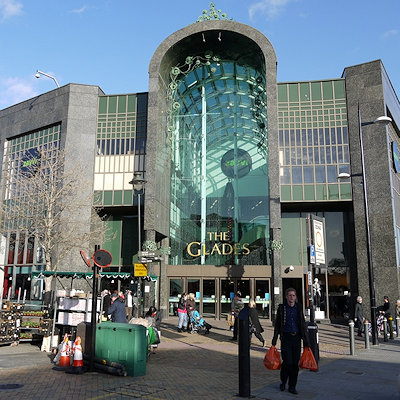
Like us on Facebook
PLACE NAMES


 
|
|
Bromley
|

|
|
|
Bromley is first recorded in a charter of 862 as Bromleag and means 'woodland clearing where broom grows'. It shares this Old English etymology with Great Bromley in Essex, but not with the Bromley in Tower Hamlets.
The history of Bromley is closely connected with the See of Rochester. In AD 862 Ethelbert, the King of Kent, granted land to form the Manor of Bromley. It was held by the Bishops of Rochester until 1845, when Coles Child, a wealthy local merchant and philanthropist, purchased Bromley Palace (now the hub of the Bromley Civic Centre) and became lord of the manor. The town was an important coaching stop on the way to Hastings from London, and the now defunct Royal Bell Hotel (just off Market Square) is referred to in Jane Austen's Pride and Prejudice. It was a quiet rural village until the arrival of the railway in 1858 in Shortlands, which led to rapid growth, and outlying suburban districts such as Bickley (which later overflowed into Bromley Common) were developed to accommodate those wishing to live so conveniently close to London.
Bromley, also known as Bromley St Peter and St Paul, formed an ancient parish in the Bromley and Beckenham hundred and the Sutton-at-Hone lathe of Kent. In 1840 it became part of the expanded Metropolitan Police District. The parish adopted the Local Government Act 1858 and a local board was formed in 1867. The board was reconstituted as Bromley Urban District Council in 1894 and the parish became Bromley Urban District. It formed part of the London Traffic Area from 1924 and the London Passenger Transport Area from 1933. In 1934, as part of a county review order, the borough was expanded by taking in 1,894 acres from the disbanded Bromley Rural District; an area including parts of the parishes of Farnborough, Hayes, Keston and West Wickham. Bromley became part of the newly created Greater London in 1965, in the new London Borough of Bromley.
The parish church of St Peter and St Paul stands on Church Road. It was largely destroyed by enemy action on 16 April 1941 and rebuilt in the 1950s incorporating the medieval tower and reusing much of the flint and fragments of the original stone building. The most noteworthy historic building is Bromley College, London Road. The central public open spaces are; Queen's Gardens, Martin's Hill, Church House Gardens, Library Gardens and College Green.
Another parish church in Bromley worth noting is St Mark's, which stands in Westmoreland Road. The present church is the third. The first was built as a temporary iron church in 1884 to cope with Bromley's growing population, on land slightly to the east of the present church, donated by a local man called Eley Soames. The road name St Mark's Road preserves the rough location of the former site.
The second church was built in brick and stone on the present site, and designed by Evelyn Hellicar, son of the then vicar of St Peter and St Paul's. It was completed in 1898 in the Perpendicular Gothic style and consecrated by William Walsh, Bishop of Dover, on 22 October that year. The tower, though, was not completed until 1904. Like St Peter and St Paul's, St Mark's was heavily damaged in the London Blitz of 1941. Only the tower survived intact.
On 3 June 1952, the Duchess of Kent laid the foundation stone of the present church, which was designed by T W G Grant and built by David Nye. Besides the tower, other parts of the fabric of the original church were used in the rebuilding. Inside there are some interesting monuments: to Samuel Ajayi Crowther, John Cole Patteson and Vedanayagam Samuel Azariah, who were all bishops in the Commonwealth.
H. G. Wells, "one of the remarkable minds of the twentieth century," was born in Bromley on 21 September 1866, to Sarah and Joseph Wells; his father was the founder of the Bromley Cricket Club and the proprietor of a shop that sold cricket equipment. Wells spent the first thirteen years of his life in Bromley. From 1874 to 1879 he attended Tomas Morley's Bromley Academy, at 74 High Street. There is an 'H. G. Wells Centre' in Masons Hill near the southern end of the High Street which houses the Bromley Labour Club. In August 2005, the wall honouring Wells in Market Square was repainted. The current wall painting features a rich green background with the same Wells reference and the evolution sequence of Homo sapiens featured in Origin of Species by Charles Darwin, a former resident of nearby Downe Village. Wells wrote about Bromley in an early unsigned article in the Pall Mall Gazette in which he expressed satisfaction that he had been born in an earlier, more rural Bromley. A blue plaque marks Wells' birthplace in Market Square, on the wall of what is now a Primark store. A marble plaque appears above the door of 8 South Street, the location of Mrs Knott's Dame school where "Bertie", as he was called as a child, learned to read and write. H.G. Wells featured Bromley in two of his novels: The War in the Air (which refers to Bromley as Bunhill) and The New Machiavelli (in which Bromley is referred to as Bromstead).
|
 Feel free to Email me any additions or corrections Feel free to Email me any additions or corrections
LINKS AVAILABLE TO YOUR SITE
| |





